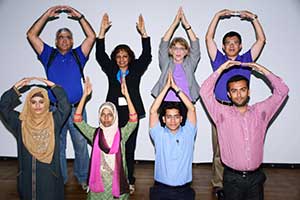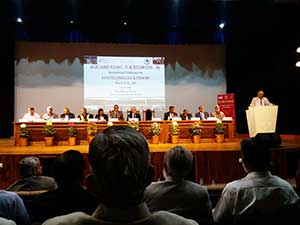OSU Stem Faculty Training Project Achieves Milestone
Sultana N. Nahar
The new STEM (Science, Technology, Engineering, Mathematics) Faculty training project of the Ohio State University (OSU) achieved a milestone with the graduation of the first group of Indian students from Aligarh Muslim University (AMU) in May 2016. To administer the final exams and research presentations of the students, the OSU team traveled to AMU in March 2016. The M.Ed is a new dual degree in the STEM program for Ph.D. students in STEM disciplines. They study in Indian institutions to learn world-class skills for teaching undergraduates and how to lead advanced research. This STEM ER (Education and Research) program, under the Education Department with STEM specialization, is unique in two respect: (1) the students take classes for training to teach undergraduate students (in contrast to teaching K-12 students as is usually done in Education Departments), and (2) carry out advanced research. The research would comprise a chapter of a Ph.D. thesis under the OSU advisor as the official co-advisor. The research is expected to continue as a long term collaboration. Under the program, a student while still in the Ph.D. program in India spends the first year at the OSU for education and for research and the second year in his/her Indian institution for field experience teaching undergraduate students and continuing research. The program was developed to address the need for better and effective educational foundations in India by Anil Pradhan and Sultana Nahar of the OSU Astronomy Department and Karen Irving of the OSU Education Department. It is funded by an Obama-Singh 21st Century Knowledge Initiative award of the US India Education Foundation (USIEF) that OSU received in partnership with AMU. India produces many excellent IT students, but they comprise only a small fraction of the 150 million students in need of better education.
To further the objective of expansion of the USIEF program to other institutions and to develop funding strategies, OSU organized with AMU the joint international conference on STEM Education and Research (STEMCON16) and Aligarh NANO-V in Aligarh during March 12-15, 2016. Various institutions in India, Bangladesh, Egypt, Russia, and the US participated. Ideas for combining teaching skills and scientific research were presented by the OSU participants, and were appreciated by the attendees from the scientific community. Presentations included internationalization of the program to developing countries, such as, Bangladesh, Egypt, Saudi Arabia, and the Republic of Georgia. The highlights of the program were communicated each day by the news media.

The four students, Nida Rehmani, Hala, Malik Azeem, and Asim Rizvi in front and their OSU advisors in back form the "O-H-I-O" sign at the completion of all the requirements for the M.Ed degree of STEM faculty training.

Inauguration session of the conference where Pradhan, Irving, and Nahar presented a summary of the STEM ER project
During this visit to India other institutions were visited to promote and expand the program. I gave public presentations, and also met with officials of government universities, such as the University of Kashmir, Central Kashmir University and Central University of Jammu, and private institutions, such as Sharda University near Delhi and Sri Mata Vaishnu Devi University in Jammu. The most attractive part of the program is the research under STEM disciplines and initiation and continuation of collaboration. One problem is the high cost of US tuition which is not supported by private institutions. Hence we are re-evaluating the scope of combining distance learning on-line courses. Our past experience for the distance learning course for the AMU students did not work well because of the communication time lag and unstable internet connections.
Under the STEM ER project, I taught a 3-weeks long condensed course on atomic astrophysics and conducted computational workshops on atomic processes at AMU. Participants were from the physics, chemistry, and computer science departments and received course certificates at the National Science Day celebration of the Physics Department.
At the same event physics prizes were awarded:
- Best research to Professor Tauheed Ahmed
- Best teaching to Professors Sabbir Ahmad and Abbas Ali and Professor Nasra Neelofar at the Women's college
- Best Ph.D. Thesis to Best B.Sc. to Dr. Md. J. Alam (male), and Dr. L.A.A. Al-Khataby (female)
- Best B.Sc. Student to Mr. S. Ahmad Shiekh (male), Ms. Fauzia (female)
At the University of Kashmir I also organized a computational workshop on atomic processes which was attended by enthusiastic members from the physics and chemistry departments. The government imposed load shedding of electricity every day from 7 to 8 pm was a deterrent since we had to rush to wrap up before darkness. Also there were opportunities to work with female students and educators. We celebrated International Women's Day at AMU where 22 women were recognized. In Kashmir at the College for Women a student from Ladakh felt very much inspired and recited the Quran emotionally to express herself.
Sultana N. Nahar is a research professor in the Department of Astronomy at Ohio State University. She has published extensively on radiative and collisional atomic processes in astrophysical and laboratory plasmas, and also worked on dielectronic satellite lines, theoretical spectroscopy, and computational nanospectroscopy for biomedical applications. Sultana Nahar is the winner of the APS 2013 John Wheatley Award. Email: nahar.1@osu.edu
